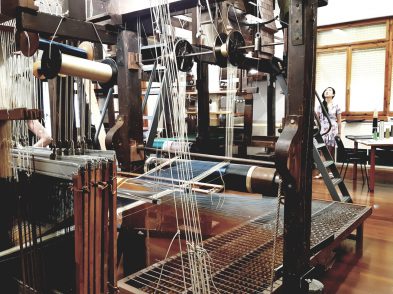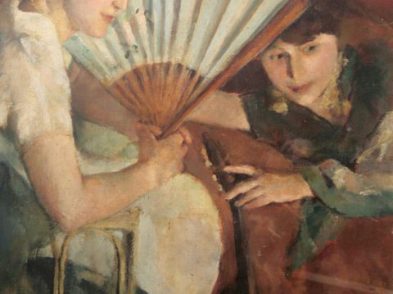The Florentine’s culture editor, Jane Fortune, scopes out a new exhibition venue and cultural center on via degli Artisti, spotlighting one of Tuscany’s top woman sculptors and her life’s work—now on permanent public view.

The interior of the new Amalia Ciardi Duprè museum in via degli Artisti, Florence
Florentine sculptress Amalia Ciardi Duprè is known for her art and her pearls of wisdom. When asked about her favorite medium—clay—she made a remark I’ll never forget: ‘The earth gives food for the body. It also gives clay to the artist, so she can make food for the soul.’
Amalia Ciardi Duprè (b. 1934) is the great-great granddaughter of Giovanni Duprè (1817–82), who was one of the most important neoclassical sculptors of the 19th century. She is named after her great-great aunt, Amalia Duprè (1842–1928), who was also a sculptress, trained by her father. The ‘first’ Amalia’s overlooked monumental marble works reside in two tabernacles outside the Duomo’s main portal (Porta Maggiore): Santa Reparata (left) and San Zenobius (right).
Ciardi Duprè attended the Academy of Fine Arts in Florence, worked in Milan and Rome and taught at the Art Institute of Porta Romana from 1970 to 1980. She has collaborated with famous architects including Roberto Monsani and Giancarlo Bicocchi, and has won many important awards over the course of her lifetime. Two small works, both titled Maternity, which the Advancing Women Artists Foundation restored in 2014, are languishing in the deposits of the Florence Civic Collections.

Sculptures at the Amalia Ciardi Duprè Museum
The 1966 Flood destroyed the Duprè’s villa and the family stayed in the refectory in the church of Santi Maria and Lorenzo, in Vincigliata. Living there for nine months, she began her eight-year quest to create, in terracotta, stories from the Old and New Testaments, in the church’s apse. Using 250 tons of clay and occupying over 400 square feet of wall space, it is one of the largest terracotta reliefs in the world and considered to be her most important work. Additional works by Ciardi Duprè are in the church of San Bernardino a Borgunto in Fiesole, which solely displays art by women, including paintings by Elisabeth Chaplin.
The Advancing Women Artists Foundation recently had the opportunity to set up an interview with the 82-year-old artist and a reporter from a national daily. Before being filmed, Ciardi Duprè was asked to simulate her creative process on camera by tinkering around with a half-finished statue. Amalia looked our way, rolled up her sleeves and got ready to work. ‘When it comes to making art, there’s no pretending,’ she said.
Amalia has been sculpting since she was five years old, when her father first brought her a package of modeling clay. Just last November—nearly 77 years after first discovering her natural aptitude for the sculptural arts—she gave Florence a lasting gift: the Amalia Ciardi Duprè Museum (Museo CAD). Since the venue’s inauguration, Florentine art lovers have gathered there to participate in its afternoon cultural programs and to view a selection of the artist’s 500-plus bronze, terracotta and cement sculptures on site. Mornings are religiously set aside for Amalia’s vocation for teaching. An all-woman entourage of sculptors seeks her artistic advice at the working studio adjacent to the new exhibition space. Surrounded by nearly a hundred of the artist’s miniature gesso models, known as bozzetti, veteran learners meet on Wednesdays, while Thursdays are for beginners only. ‘We each wait for Amalia to pass by our tables,’ reported a student with nine years of training under her belt. ‘She’ll stop, reach out and press her thumb into a clay model that I can’t quite get right. And, suddenly, it works. A thumbprint and it works!’

‘Toward Peace’ can be found on the museum’s loft-like top floor.
The museum, located at via degli Artisti 54r, is in a neighborhood officially named a Florentine Artists’ District in 1874. Bronze religious works inspired by Christianity, colorful preparatory sketches, large-scale mythological pieces depicting Greek and Roman deities abound there. The entrance is ‘guarded’ by a huge representation of the Earth Goddess, Demeter, and her long-lost daughter, Perséphone, that represent the coming of spring. Smaller ‘Mother’ sculptures surround them. Another favorite feminine sculpture called ‘Toward Peace’ can be found on the museum’s loft-like top floor. Don’t miss exploring contemporary art, through her sculptures, which selflessly she has shared with the world.
Fondazione Amalia Ciardi Duprè
via degli Artisti 54r, Florence
Open Monday–Saturday 10am–12.30pm, 3.30–5.30pm
Guided tours are available on request








